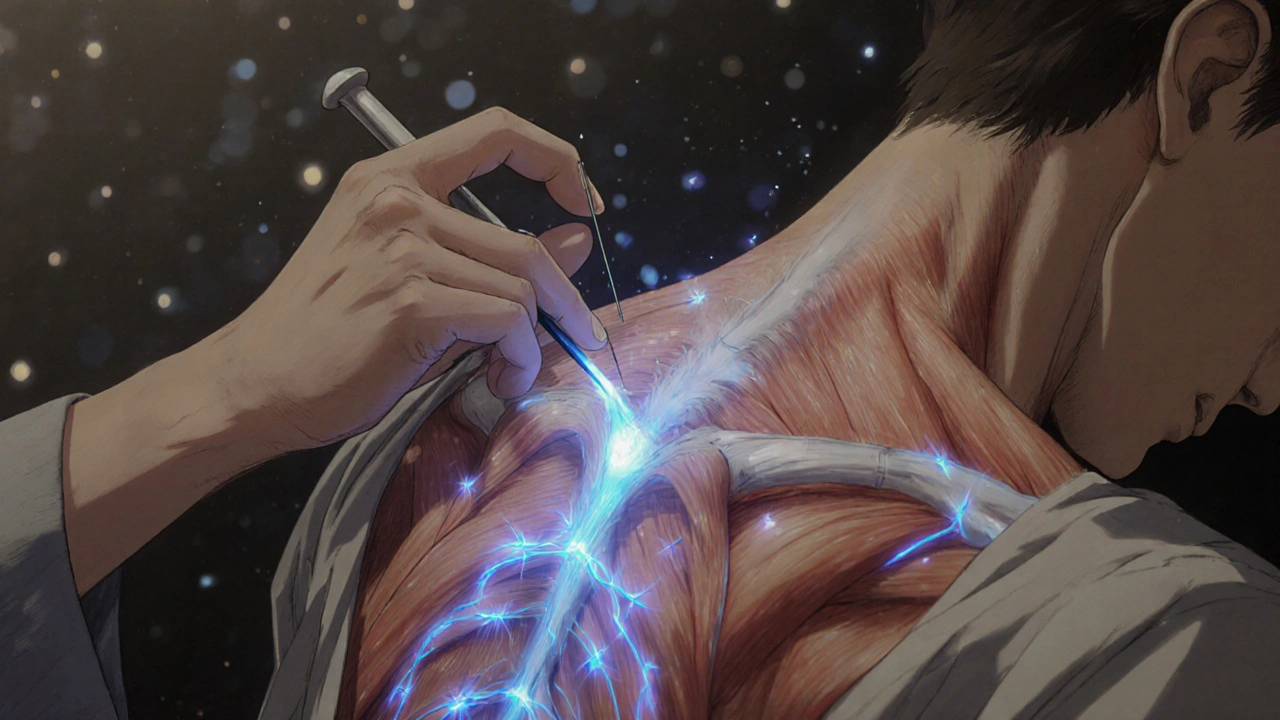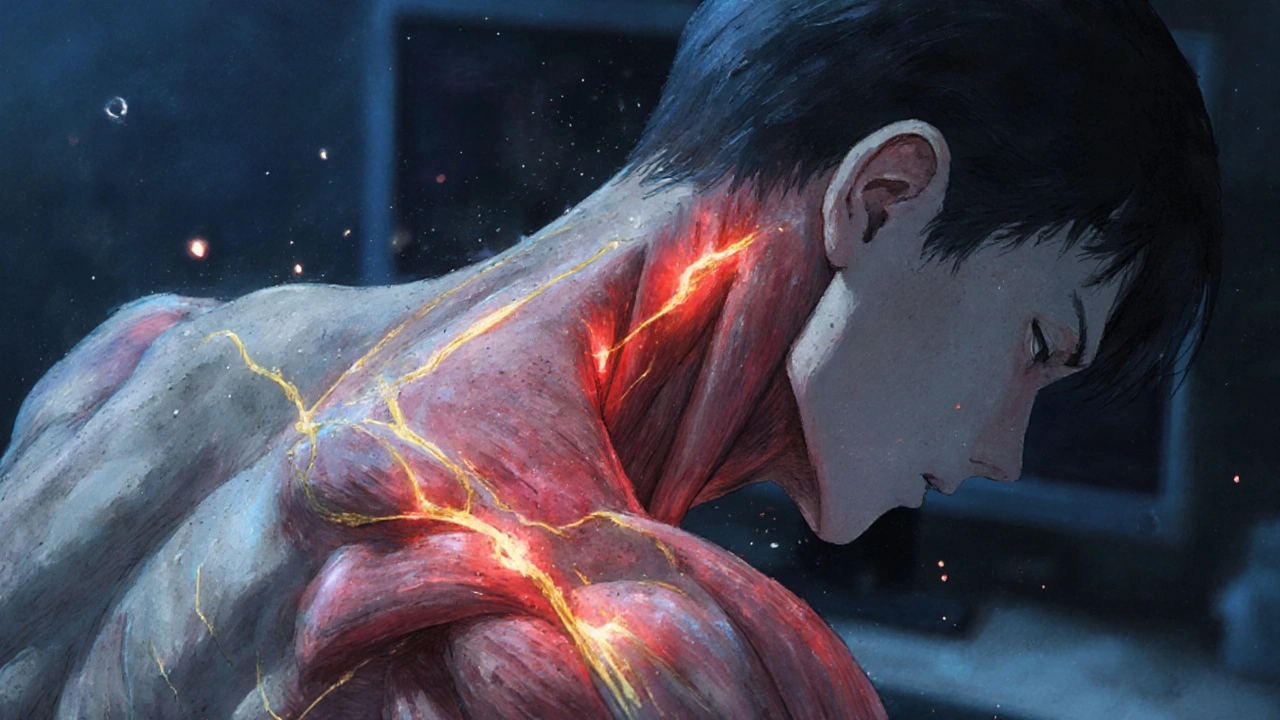If you’ve been told your shoulder, neck, or jaw pain is "just muscle tension," but nothing seems to help-chances are, you’re dealing with myofascial pain syndrome (MPS). It’s not just soreness. It’s not just stress. It’s a real, measurable condition rooted in tight, irritated spots inside your muscles called trigger points. These aren’t imaginary. They’re physical knots that send pain racing across your body, often mimicking nerve pain, headaches, or even heart issues. And here’s the kicker: up to 85% of people visiting pain clinics have MPS, but most are never properly diagnosed.
What Exactly Are Trigger Points?
Trigger points are tiny, hyperirritable nodules inside taut bands of muscle. Think of them like electrical short circuits in your muscle fibers. They’re usually 2 to 10 millimeters wide-small enough to miss on an MRI, but painful enough to wreck your sleep, posture, and daily movement. They’re not the same as tender points (which you feel with fibromyalgia). Trigger points are in the middle of muscle bellies, not at tendons or joints. And they don’t just hurt where you press them-they refer pain elsewhere.For example, a trigger point in your upper trapezius (the muscle that runs from your neck to your shoulder) can make your temple throb like a migraine. A trigger point in your levator scapulae (that deep neck muscle) can cause pain behind your eye or down your arm. That’s why so many people get misdiagnosed with pinched nerves or TMJ disorder. In fact, about 30% of patients told they have radiculopathy actually have trigger points causing the same symptoms.
These knots form because of sustained muscle contraction. Your muscle fibers lock up, cutting off blood flow. That leads to a drop in pH-your muscle tissue becomes acidic-and chemicals like acetylcholine, serotonin, and noradrenaline flood the area. These chemicals keep the pain signals firing, even when you’re not moving. It’s a self-sustaining loop: pain causes tension, tension causes more pain.
How Do You Know It’s Trigger Points and Not Something Else?
Diagnosing MPS isn’t about scans. It’s about touch. A trained practitioner looks for four key signs:- A taut band you can feel under your fingers-like a tight guitar string in the muscle
- Local tenderness when you press on it
- Pain that refers to a predictable pattern (like from your shoulder blade to your hand)
- A local twitch response-a quick, involuntary muscle spasm when you press or snap the trigger point
These signs show up in about 70-85% of active trigger points. Latent trigger points? They’re quiet until you press on them. You might have them and not know it-until you twist wrong or sit too long, and then boom, pain flares.
It’s important to rule out fibromyalgia. Fibromyalgia causes widespread, symmetric tenderness all over your body, mostly at tendon insertions. MPS is regional. It’s in specific muscles. It’s not everywhere. And unlike fibromyalgia, MPS pain can be turned off-with the right technique.
What Causes Trigger Points to Form?
Trigger points don’t appear out of nowhere. They’re the result of something your body has been forced to endure:- Posture: Slouching at a desk for years? Your upper trapezius and levator scapulae are screaming. Forward head posture increases trigger point risk by 3 to 5 times.
- Trauma: Whiplash from a car accident? About half of people who get it develop MPS within months.
- Structural issues: One leg longer than the other? That imbalance puts constant strain on your hips, lower back, and shoulders.
- Nutrition: Low vitamin D (under 20 ng/mL) is linked to a 60% higher chance of MPS. Hypothyroidism is found in 15-25% of chronic cases.
- Overuse: Repetitive motions-typing, lifting, carrying bags on one shoulder-keep muscles locked in contraction.
It’s rarely one thing. It’s usually a combo. You’re sitting wrong, you’re stressed, you’re low on vitamin D, and you’ve got a minor leg length difference. That’s the perfect storm for trigger points to take root.

Trigger Point Release Techniques That Actually Work
There are several ways to break the cycle. Not all of them work equally well. Here’s what the evidence says:1. Ischemic Compression
This is the most accessible method. You press directly on the trigger point with your thumb, knuckle, or a tennis ball. Hold the pressure for 30 to 90 seconds until the pain eases by about 50%. You might feel a dull ache, then a release. The goal is to reduce the chemical overload and restore blood flow.
Studies show 60-75% of people get short-term relief. It’s cheap, safe, and you can do it at home. A lot of people swear by using a lacrosse ball against a wall for their back or a foam roller for their glutes. One Reddit user said: "Ischemic compression helped my TMJ pain more than the $400 mouthguard."
2. Dry Needling
Dry needling uses thin needles-like acupuncture needles-to poke right into the trigger point. It doesn’t inject anything. The needle itself triggers a local twitch response. That twitch is a good sign. It means the muscle fiber is releasing.
Research shows 65-80% of patients get pain relief that lasts 4 to 12 weeks. It’s more effective than massage alone. A 2020 meta-analysis found it’s just as good as trigger point injections (with lidocaine) at the 4-week mark. The big advantage? No drugs. No side effects. The downside? You need a trained professional. Badly done, it can make things worse.
3. Trigger Point Injections
These are injections of local anesthetic (like lidocaine) directly into the trigger point. They’re fast. Most people feel relief within minutes. Studies show 70-85% immediate pain reduction. But the effect doesn’t last forever-usually 2 to 8 weeks. A Cochrane Review found no real difference between lidocaine injections and dry needling after four weeks. So if you’re avoiding needles or drugs, dry needling is just as good.
4. Spray and Stretch
This one’s old-school but still useful. A cold spray (like ethyl chloride) is sprayed over the skin along the path of the referred pain. Then the muscle is stretched. The cold numbs the area, making it easier to stretch without triggering a pain reflex. It works best for neck and shoulder pain. About 50-65% of patients see improvement.
5. Instrument-Assisted Soft Tissue Mobilization (IASTM)
Therapists use metal or plastic tools to scrape along the muscle fibers. It’s like deep tissue massage with a tool. It helps break up adhesions and stimulate blood flow. Efficacy is around 55-70%. It’s not as well studied as dry needling, but many physical therapists swear by it.
6. Low-Level Laser Therapy (LLLT)
This uses red or near-infrared light (808-905 nm) on the trigger point. It reduces inflammation and helps cells heal. Studies show 40-60% pain reduction. It’s not a magic bullet, but it’s safe and can be used alongside other treatments.
Why Do Some People Not Get Better?
Because treatment isn’t just about the technique-it’s about consistency and context.A 2020 study of over 1,200 MPS patients found that those who got combined treatment-manual therapy, dry needling, and a home stretching program-had a 65% drop in pain at 12 weeks. Those who got just one thing? Only 35% improvement.
And here’s the hard truth: 40-60% of people see their pain come back within six months if they stop doing the work. Trigger points don’t vanish permanently. They’re like weeds. You pull them, but if the soil stays bad, they grow back.
One patient on Reddit wrote: "After 3 dry needling sessions, my shoulder pain dropped from 8/10 to 3/10. But after 8 weeks, it crept back to 6/10. I didn’t keep up with the stretches."
Another problem? Practitioner skill. A 2019 survey found that 32% of patients got no relief-or worse-after treatment from someone without proper training. Trigger point identification isn’t easy. It takes 6 to 12 months of supervised practice to get good at it. Mastery? Two to three years.

What You Can Do at Home
You don’t need to spend hundreds on therapy to manage this. Here’s a simple daily protocol:- Heat first: Use a heating pad or warm towel on the sore area for 15 minutes at 40-45°C. Heat relaxes the muscle and increases blood flow.
- Self-compression: Use a tennis ball, lacrosse ball, or foam roller. Roll slowly over the tight band. When you hit a knot, hold pressure for 60 seconds. Breathe. Don’t tense up.
- Stretch: After compression, gently stretch the muscle. For upper traps: tilt your head to one side, keep your shoulder down. Hold 30 seconds. Repeat 3 times.
- Posture checks: Every hour, reset your posture. Shoulders back, chin slightly tucked. No more craning at screens.
- Check your vitamin D: Get a blood test. If you’re under 30 ng/mL, supplement. It makes a measurable difference.
Compliance is low-only 45-60% of people stick with home care for more than six weeks. But those who do? They’re the ones who stay pain-free.
The Bigger Picture: Why This Matters
MPS isn’t just a nuisance. It’s a major driver of healthcare costs. In the U.S., each patient spends an average of $2,850 a year-mostly on unnecessary MRIs, nerve conduction tests, and opioid prescriptions. That’s because doctors often mistake MPS for something structural or neurological.But as opioid use declines, non-drug pain management is booming. Referrals for physical therapy, dry needling, and manual therapy have grown 200% since 2015. MPS treatment is now a cornerstone of modern pain care.
And the science is catching up. Researchers are now measuring biomarkers in trigger points-substance P, bradykinin, TNF-alpha-all elevated in painful areas. Ultrasound-guided injections and neuromodulation are being tested in 12 ongoing clinical trials. We’re moving from "it’s all in your head" to "here’s the biology. Here’s how to fix it."
Final Thoughts
Myofascial pain syndrome is real. Trigger points aren’t myth. They’re physical, measurable, and treatable. But they won’t go away with rest, painkillers, or hope.If you’ve been told your pain is "just stress" and nothing helps, ask for a trigger point evaluation. Find a physical therapist, chiropractor, or doctor trained in myofascial release. Start with self-care: heat, compression, stretching, posture. Don’t wait for a miracle. Treat it like rehab for your muscles.
The pain doesn’t have to be your new normal. You just need to know where to look-and how to release it.
Can trigger points show up on an MRI or X-ray?
No. Trigger points are too small and don’t show up on imaging like MRI, X-ray, or CT scans. They’re diagnosed through physical exam-palpation of taut bands, referred pain patterns, and local twitch responses. That’s why many people get misdiagnosed-they’re sent for scans that come back "normal," even though the pain is very real.
Is dry needling the same as acupuncture?
No. Acupuncture is based on traditional Chinese medicine and targets energy meridians. Dry needling targets specific muscle trigger points based on anatomy and physiology. The needles are the same, but the technique, location, and purpose are completely different. Dry needling is grounded in Western medical science.
How long does it take to see results from trigger point therapy?
Some people feel relief after one session-especially with dry needling or injections. But lasting results take time. Most studies show significant improvement after 3 to 6 sessions over 4 to 8 weeks. The key is combining professional treatment with daily self-care. One session won’t fix years of poor posture or muscle imbalance.
Can trigger points cause headaches?
Yes. Trigger points in the upper trapezius, levator scapulae, and temporalis muscles are common causes of tension headaches and even migraine-like pain. Many people who think they have migraines are actually suffering from myofascial pain referred from the neck and jaw muscles. Treating these trigger points often reduces headache frequency and intensity significantly.
Why does my pain come back after treatment?
Because the root causes haven’t changed. If you’re still sitting with rounded shoulders, lifting heavy objects with bad form, or sleeping in a twisted position, your muscles will tighten again. Trigger points are symptoms, not the disease. The disease is your movement pattern, posture, or stress load. Treatment works best when you fix the cause-not just the knot.
Are trigger point injections safe?
Yes, when done by a trained professional. The most common side effect is temporary soreness at the injection site. Rare risks include bleeding, infection, or puncturing a lung (if treating near the chest wall). Lidocaine is used in low doses and doesn’t contain epinephrine, which minimizes side effects. It’s safer than long-term opioid use and often more effective than over-the-counter painkillers for this type of pain.
Can vitamin D deficiency make trigger points worse?
Yes. Studies show people with vitamin D levels below 20 ng/mL have a 60% higher risk of developing myofascial pain syndrome. Vitamin D helps regulate muscle function and reduce inflammation. If you have chronic muscle pain and low vitamin D, correcting the deficiency can significantly improve your response to trigger point therapy.



16 Comments
Holli Yancey
November 18, 2025 AT 19:54I never realized how much my slouched posture at my desk was wrecking my neck. After reading this, I started using a lacrosse ball every night before bed-honestly, it’s been a game changer. No more waking up with that dull headache.
Still can’t believe how many people get misdiagnosed with migraines when it’s just trigger points. I wish my doctor had mentioned this years ago.
Gordon Mcdonough
November 20, 2025 AT 15:30THIS IS WHY AMERICA IS FALLING APART!! PEOPLE ARE TOO LAZY TO FIX THEIR OWN BODIES!! YOU THINK A BALL IS GONNA FIX YOUR POSTURE?? GET A JOB THAT DOESN’T MAKE YOU SIT LIKE A SLUG!!
AND WHY ARE WE PAYING FOR DRY NEEDLING WHEN WE COULD JUST STAND UP??!??!??!??
Jessica Healey
November 21, 2025 AT 06:08omg yes!! i had this pain in my shoulder for like 3 years and everyone told me it was stress?? i finally saw a PT who did dry needling and it was like someone turned off a switch. i cried. not even kidding.
also vitamin d?? i was at 18 ng/ml. started taking 5k daily and my pain dropped by like 70% in 6 weeks. science is wild.
ps: i still use the tennis ball trick every morning. its my little ritual.
Levi Hobbs
November 21, 2025 AT 20:04Great breakdown. I especially appreciate how you distinguished between trigger points and fibromyalgia. So many people conflate them.
For anyone trying ischemic compression: don’t rush it. Hold for the full 90 seconds-even if it’s uncomfortable. The twitch response is the key. I’ve had patients who gave up after 20 seconds and wondered why it didn’t work.
Also, posture checks every hour? Non-negotiable. I set a timer. It’s annoying, but worth it.
henry mariono
November 23, 2025 AT 00:04Interesting. I’ve had this pain for years, but never thought to look into trigger points. I’ll try the ball technique this weekend. Thanks for sharing.
Sridhar Suvarna
November 23, 2025 AT 11:20Excellent article. In India, this condition is largely ignored due to lack of awareness. Physical therapists are scarce, and most patients are prescribed painkillers without proper diagnosis.
My uncle suffered from chronic neck pain for 8 years. He was finally diagnosed after visiting a physiotherapist trained in myofascial release. He now does daily stretches and uses a foam roller. Pain reduced by 80%.
Knowledge is power. Please share this with more people.
Joseph Peel
November 24, 2025 AT 11:56Trigger points are not a myth. They are a physiological reality grounded in neuromuscular dysfunction. The fact that they remain underdiagnosed speaks to the fragmentation of modern medical education.
It is not sufficient to rely on imaging when palpation and clinical pattern recognition are superior diagnostic tools for this condition.
Furthermore, the integration of self-care modalities-heat, compression, stretching-is not merely supportive; it is essential for long-term resolution. This is biomechanical rehabilitation, not alternative medicine.
Kelsey Robertson
November 24, 2025 AT 18:49Oh please. This is just the new-age version of ‘your pain is in your muscles’ so doctors don’t have to admit they don’t know what’s wrong.
And why are we suddenly trusting ‘Reddit users’ who say their TMJ got better from a tennis ball? Where’s the double-blind RCT? Where’s the peer review?
Also, vitamin D? Really? That’s your solution? You think your pain is from being indoors too much? Maybe you should stop living like a vampire and go outside.
And dry needling? That’s just acupuncture with a fancy name. I’m not buying it.
Joseph Townsend
November 26, 2025 AT 04:11MY FINGERS HAVE BEEN CRAMPED FOR 14 YEARS AND I THOUGHT IT WAS JUST ‘AGING’ UNTIL I STUCK A LACROSSE BALL UNDER MY SCAPULA AND FELT A TIGHT STRING THAT MADE ME SCREAM LIKE I WAS IN A HORROR MOVIE.
THEN I DID THE STRETCH AND IT FELT LIKE A KNOT UNRAVELING IN MY SOUL.
IT WASN’T PAIN. IT WAS REVELATION.
IF YOU’RE STILL TAKING IBUPROFEN AND CALLING IT A DAY, YOU’RE NOT LIVING-YOU’RE SURVIVING IN A TIGHT MUSCLE PRISON.
GO GET A TENNIS BALL. NOW.
AND THANK ME LATER.
Bill Machi
November 27, 2025 AT 14:47Another feel-good article from someone who thinks a foam roller can fix systemic issues. Let me guess-no mention of the real problem: the decline of manual labor, the rise of sedentary jobs, and the collapse of physical education.
Meanwhile, the medical-industrial complex profits from endless scans and pills while pretending this is just about ‘trigger points.’
And don’t get me started on vitamin D. You think a supplement fixes what corporate America broke? Wake up.
Elia DOnald Maluleke
November 27, 2025 AT 18:30In the town where I grew up in South Africa, our grandmother would rub warm olive oil on our stiff shoulders and say, ‘The body remembers what the mind forgets.’
This article, though clinical in tone, echoes that ancient wisdom. The trigger point is not merely a knot-it is a silent cry from the body, a memory of stress, trauma, and neglect.
We must treat it not as a malfunction to be erased, but as a messenger to be listened to.
And yes-vitamin D matters. So does rest. So does silence.
satya pradeep
November 29, 2025 AT 03:00bro i had this pain in my lower back for 2 years and i thought it was a herniated disc. got an mri, everything normal. then i found this article and tried the lacrosse ball on my glutes. holy crap. i found a knot the size of a marble. held it for 2 mins and my whole leg stopped tingling.
now i do it every day before bed. also took vit d and my energy is way better. thanks for this.
Prem Hungry
November 29, 2025 AT 21:07Dear friend,
Thank you for this thoughtful and deeply informative article. My father, a retired construction worker, suffered from chronic shoulder pain for over a decade. He was misdiagnosed with arthritis. After learning about trigger points, we began the daily protocol you described-heat, compression, stretching. Within three weeks, he was able to lift his arm again without pain.
Never underestimate the power of simple, consistent care. You have given hope to many.
With gratitude,
Prem
Leslie Douglas-Churchwell
December 1, 2025 AT 05:11⚠️ ALERT: This is a corporate pharmaceutical distraction tactic. Trigger points? Pfft. They’re just the body’s way of signaling that your lymphatic system is clogged from glyphosate-laced food, 5G radiation, and fluoride in the water.
Also, dry needling? That’s just a gateway to Big Pharma’s next injection scam. They don’t want you to know that cold laser therapy + magnesium oil + infrared sauna is the REAL solution.
And vitamin D? You need 10,000 IU daily-NOT 5k. And you need to take it with K2, or you’ll calcify your arteries. 🧠💊
Also, your posture? It’s not your fault. It’s the government’s fault for designing chairs that enslave your spine. #WakeUp
shubham seth
December 1, 2025 AT 12:10Let’s be real-this is just a fancy way of saying ‘your muscles are tight because you’re a lazy slob who sits all day.’
None of this would be a problem if people actually moved. No ball, no needle, no vitamin D is going to fix the fact that you’re addicted to your phone and your couch.
Also, ‘trigger point therapy’ is just a marketing term for massage. Stop pretending it’s science. It’s just touch. And touch doesn’t fix systemic dysfunction.
But hey, if it makes you feel better, go ahead. Buy the lacrosse ball. Write your gratitude letter to your glutes. I’m not stopping you.
Holli Yancey
December 1, 2025 AT 17:56Levi, you’re so right about holding the pressure long enough. I used to give up too soon. Now I breathe through it. It’s weird-when I stop tensing up, the pain actually fades faster.
Also, the timer thing? I started doing that too. Every hour. Even if I’m in the middle of a Zoom call. I just stand up, stretch, and roll my shoulders. Feels like a tiny reset.
Thanks for the reminder.